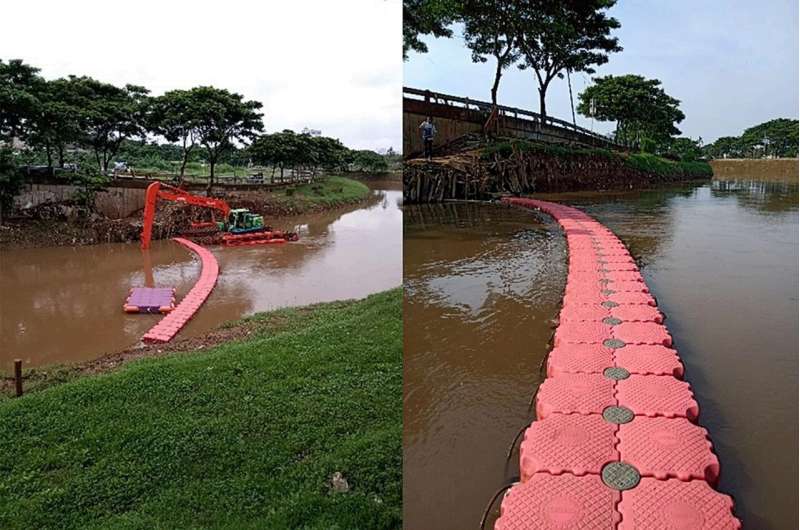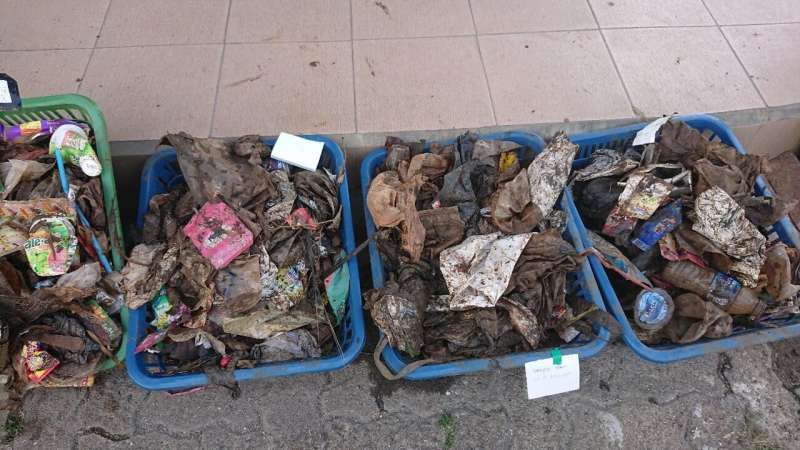Volume of plastic waste in Jakarta rivers revealed

From 2019 to 2022, Prof. Takanobu Inoue of Toyohashi University of Technology conducted a joint research project with his research team titled "Estimation of amount of release of plastics to the ocean in Indonesia" under bilateral cooperative programs of the Japan Society for the Promotion of Science.
In Jakarta (Indonesia), waste being carried downstream is trapped by a floating contraption involving floats attached to the top of fence posts across the river. The collected garbage was sorted to clarify how much plastic was in the waste. As a result, some 78% was deemed to be plastic, equating to an estimated daily discharge rate of 7.7–12.6 grams per person that would eventually find its way to the ocean.
Marine pollution caused by microplastics has become a global environmental issue, with ever more plastics being detected in the bodies of marine and avian wildlife. Globally, Indonesia is second in terms of plastic emissions into the ocean, while Southeast Asian countries in general also lag behind in creating and managing plastic waste.
Away from urban areas, waste is not generally collected, with domestic waste typically being thrown away behind houses or along rivers. Although the proportion of plastic in such waste has recently increased, there has not been any change in how it is being disposed of, while the actual volume of garbage disposed is also increasing due to economic growth. Such waste is carried downstream to the ocean via rivers, especially when currents surge after heavy rainfall. In order to clarify the true status, Prof. Inoue's research team initiated a study using a variety of methods to estimate how much plastic is being discharged into the ocean.
As this research was the first study into waste runoff conducted by this team, they began by assessing how to collect data. Various methods were tried, including having students line up across the river and collecting floating garbage for 10 minutes, or by using nets to collect the trash. However, while assessing some rivers in Jakarta, it was observed that floating waste was being trapped as it flowed downstream by floating booms installed on fence posts across rivers.
A hydraulic shovel was set up on the riverbank to remove the accumulated waste, which was then loaded onto trucks to be transported to a waste disposal site. The research team sampled this collected waste, and after sorting, determined that the average ratio of plastics in this waste was 78%; of which, PET bottles and store-issued plastic bags accounted for more than half. However, the proportion of straws—currently considered problematic in Japan—was small.
Based on the amount recovered, we estimated that the daily amount that would be discharged into the ocean if there were no collection equipment would be in the range 7.7 to 12.6 gram per person.
The most widely used estimate at the moment for the daily amount of plastic discharged into the ocean from Indonesia is 18.9 gram per person. Although this is a lower value, it nonetheless indicates that a vast amount of plastic is being discharged into the ocean via river systems.
These research results have been published in the Marine Pollution Bulletin.

This research team has been conducting a "Survey into Plastic Volume Discharged via Rivers in Indonesia" as Grant-in-Aid for Scientific Research since this fiscal year, by targeting rivers in cities and nearby rural areas in Indonesia—from which waste is not collected directly. A similar survey is also to be conducted in Japan, and by comparing the results, we intend to clarify more accurately how much plastic is discharged across Indonesia, while also discussing measures with Indonesian researchers to reduce plastic discharge into the ocean.
Furthermore, through this research, we also strive to bolster the skills of environmental engineering researchers by teaching basic research methodology for environmental engineering to young Indonesian researchers with environmental engineering credentials.
More information: Mega Mutiara Sari et al, Plastic pollution in the surface water in Jakarta, Indonesia, Marine Pollution Bulletin (2022). DOI: 10.1016/j.marpolbul.2022.114023
Journal information: Marine Pollution Bulletin
Provided by Toyohashi University of Technology





















